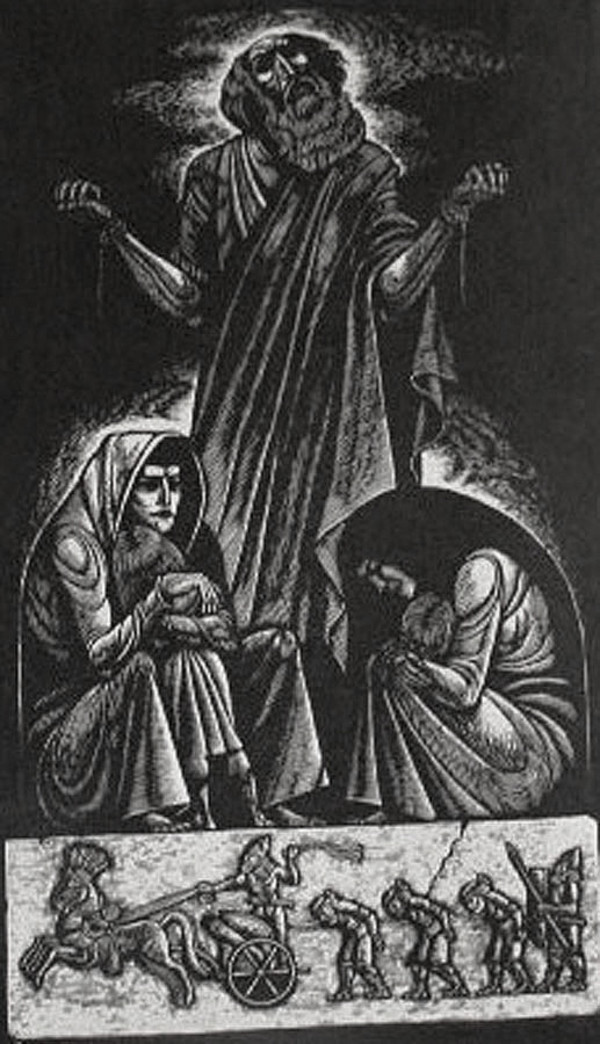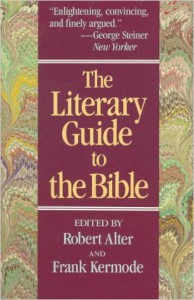
Image from www.oneyearbibleblog.com
[First posted in 2013. The original Introduction:
It is timely to feature a book which, most likely, few students venture into reading; for why would anyone wish to vicariously experience the horror of witnessing YHWH’s destruction of the remnant of His people, in His center of worship and governance? Why timely? Because the 9th of Av is a date on which tragic events have occurred in the history of Israel. This commentary is from the book we have featured here as MUST READ/MUST OWN, THE LITERARY GUIDE TO THE BIBLE.
Reformatted and highlighted for S6K post.—Admin1.]
————————–
- for the destroyed cities of Sumer,
- laments for the dying god Tammuz,
- and, in the Bible, David’s laments for Saul and Jonathan and for Abner.
The Prophets, especially Ezekiel, compose derisive laments for the cities whose doom they foretell.
- restore the dead to the human community,
- articulate the inexpressible,
- turn death into beauty.
- it consummates the prophecy.
- It preserves for us the direct impact of the fall of Jerusalem.
- But with one reservation: there are five laments.
- Each has its own perspective,
- its own vocabulary
- and rhetorical technique,
- linked by the form (the acrostic, whereby each verse begins with its corresponding letter of the Hebrew alphabet)
- and by verbal and thematic correspondences.
- explain,
- illustrate,
- and thus mitigate the catastrophe,
- to house it in a familiar literary framework;
- it must also communicate its own inadequacy.
Its success, in a sense, depends on its failure. This happens, for example, if a poem fades out in a whimper or an ineffectual cry for revenge, and it has to recognize the silence that exhausts it, the power of the enemy, and the necessity of starting again. But this success through the enactment of inadequacy is also reflected, as always, in the details of language.
- is she bereft of her people,
- of YHWH,
- of her lovers,
- or of all three?
This simile complements “she has become tributary” [AT] at the end of the second line; the repeated verb “has become,” together with the opening “doth sit,” imposes a stillness and finality on the verse that also permeates the second: “She weepeth sore [literally, ‘Weeping she weeps’] in the night, and her tears are [literally, ‘tear is’] on her cheeks [literally, ‘cheek’]: among all her lovers she hath none to comfort her.” The repetition of the verb “weep,” though a Hebrew emphatic idiom, suggests reiteration, an ever-replenish plaint: it could well be a model for the book. The sorrow is silhouetted by the quiet of the night and the destroyed city. But the figure of continuity and repetition is juxtaposed with one of arrested time: “her tear is on her cheek.” It is as if she will never escape this moment. This introduces a powerful motif of the first chapter, “There is none to comfort her.”
- of the poet
- and the poem,
- as an attempt at response and consolation?
And further, what is the function of the arch comforter, God?
- Jerusalem has sinned,
- its prophets lied,
- they shed innocent blood, and so forth—
- without apparent question (at least until the very end, 5:20), as if a bad explanation were better than no explanation, and juxtaposes them with descriptions of misery.
Parataxis works to establish not connections but dissonances. This is very clear in chapter 2, the second poem in the sequence, where God’s wrath is contrasted without comment with the grief of the aged and the young girls, the incessant weeping of the poet, and the starvation of children.
- The mothers eat their children,
- to whom they cannot give suck;
- the mourners,
- covered in ritual ash,
- lie dead in the dust.
- In the first half of the chapter,
- which is an unremitting, frightening, yet almost objective account of God’s onslaught,
- the focus is essentially on physical destruction
- and the paradox of God’s violation of his own holy place;
- in the second half of the chapter,
- the catastrophe is solely and gratuitously human.
Yet the sacrilege and the human suffering cannot be entirely dissociated, because the victims are God’s children.
- priest
- and prophet,although the prophets have ceased to receive visions (2:9)
- killed in the sanctuary (2:20),
- and have prophesied falsely (2:14).
- but also God is being induced to recognize equated through parallelism in 2:20 to the starving and cannibalized children.
- that despite their wrongdoing
- they are his servants,
- But this might also be a metaphorical equivalence: like the children sucking dry breasts,
- the prophets receive no vision, there is no Torah (2:9),
- and God greedily swallows—just like the death-god Mot in Canaanite myth—his people (2:2, 5, 8).

Image from sacredartpilgrim.com
- the metaphor of God as an enemy who destroys what is his.
- The fortresses of the daughter of Judah(v. 2)
- are really his fortresses (v. 5),
- over which she laments (v. 5).
- He substitutes for his mo’ed—
- meaning both “festival”
- and “appointed time”
- —the celebration of the victors in the Temple (v. 7).
- seasons of remembrance,
- points of contract between contingent time and mythic time,
- and hence assertions of cosmic order.
In erasing this memory, God implicitly annuls the symbolic links through which we situate ourselves in the world; amnesia is a reversion to chaos.
- once by the grief of the daughter of Judah (2:5),
- and a second time by that of the walls of Jerusalem, in a lovely alliterating phrase waya’avel hel wehomah yahdaw ‘umlalu, “therefore he made the rampart and the wall to lament; they languished together” (2:8). The weeping of stones (see 2:18) appeals against God’s relentlessness.
- Mothers are as cruel to their children as the proverbial ostriches;
- the sin of Jerusalem was worse than that of Sodom;
- its Nazirites were whiter than snow, are now blacker than black.
These insistent comparisons set the catastrophe in a context that is partly literary, partly historical. The carelessness of ostriches (4:3) effects a spatial displacement to the wilderness, to the absurdity of nature, as in God’s speech from the whirlwind in Job, and the comparison is of course unfair to the mothers of Jerusalem, and consequently a conceit.
- the growing claustrophobia,
- the celerity of the enemy,
- the capture of the king.
A feature of this description is emotional economy; for example, the king is depicted as “the breath of our nostrils, the anointed of the Lord” (4:20). (The image is very ancient and has been found in the Tel-el Amarna letters, written a thousand years earlier.) He signifies at once—
- the vitality of the state through which his subjects live,
- and a divine effluence, as the one who directs his kingdom.
The perception is appropriate and comprehensive; elsewhere in the book, however, it might have been greatly expanded.
- On each side, two chapters of twenty-two verses each surround one of sixty-six verses;
- each except the last in an alphabetic acrostic (the third chapter is a triple acrostic;
- hence its sixty-six verses).
This formal arrangement is useful for the study of Hebrew metrics, since for once we know where verses begin and end. The acrostic provides a purely external structure for the poem, predictable and yet open to all the possibilities of expression and fragmentation. This assurance and freedom counteract the loss of political and religious structure described in the poem. They may be seen as an ironic wish-fulfilling gesture, an ineffectual assertion of control over language, and hence over thought, in the face of devastating reality. But this formal structure works on a deeper level.
- a sign of language—
- the system of signs—
- in which all the letters of the alphabet cooperate to generate meaning.
- Beyond this it is a sign language–
- as play,
- free of signification,
- of the multiple word games that permeate Hebrew poetry.
- Language is
- self-fulfilling,
- self-gratifying.
We return to the theme of the first chapter: “She hath none to comfort her.”
- turning the weeping into differentiated poems and words,
- human desolation into grandeur.
That plangent phrase recurs through the chapter,
- changing context,
- seeking a corresponding phrase of consolation from God as well as from Zion’s faithless lovers,
- eliciting identification and appeasement from us.
So the phrase, like the poem,
- speaks of our solitude amid our ruins,
- that the destruction to which it bears witness should turn to hope.

